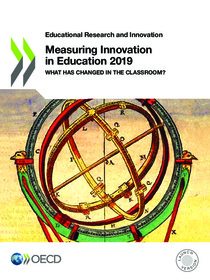Measuring innovation in education 2019: what has changed in the classroom?
"Measuring innovation in education and understanding how it works is essential to improve the quality of the education sector. Monitoring systematically how pedagogical practices evolve would considerably increase the international education knowledge base. We need to examine whether, and how,...
| Main Authors: | , , , |
|---|---|
| Institution: | ETUI-European Trade Union Institute |
| Format: | TEXT |
| Language: | English |
| Published: |
Paris
2019
OECD |
| Subjects: | |
| Online Access: | https://www.labourline.org/KENTIKA-19305805124911230879-Measuring-innovation-in-educat.htm |
| _version_ | 1771659894401794049 |
|---|---|
| author | Vincent-Lancrin, Stéphan Urgel, Joaquin Kar, Soumyajit Jacotin, Gwénaël |
| author_facet | Vincent-Lancrin, Stéphan Urgel, Joaquin Kar, Soumyajit Jacotin, Gwénaël |
| collection | Library items |
| description | "Measuring innovation in education and understanding how it works is essential to improve the quality of the education sector. Monitoring systematically how pedagogical practices evolve would considerably increase the international education knowledge base. We need to examine whether, and how, practices are changing within classrooms and educational organisations and how students use learning resources. We should know much more about how teachers change their professional development practices, how schools change their ways to relate to parents, and, more generally, to what extent change and innovation are linked to better educational outcomes. This would help policy makers to better target interventions and resources, and get quick feedback on whether reforms do change educational practices as expected. This would enable us to better understand the role of innovation in education. This new edition of Measuring Innovation in Education examines what has (or has not) changed for students over the past decade in OECD education systems. It reviews no fewer than 150 educational practices. The report casts light on systemic innovation in primary and secondary education, with a focus on pedagogical innovation. Has the use of technology spread? Have assessments become more important in pedagogical practices? Are students given more agency in their learning? Are they still asked to memorise facts and procedures? Do teachers increasingly engage students in peer learning activities? These are some of the questions this book seeks to answer. This report also presents some preliminary findings about the links between innovation and educational performance. This book will offer precious insights to policy makers, the education community and all those who seek to understand how educational practices are evolving." |
| format | TEXT |
| geographic | OECD countries |
| id | 19305805124911230879_f2d8c7cb751249218cf2413b09a203b0 |
| institution | ETUI-European Trade Union Institute |
| is_hierarchy_id | 19305805124911230879_f2d8c7cb751249218cf2413b09a203b0 |
| is_hierarchy_title | Measuring innovation in education 2019: what has changed in the classroom? |
| language | English |
| physical | 336 p. Digital |
| publishDate | 2019 |
| publisher | Paris OECD |
| spellingShingle | Vincent-Lancrin, Stéphan Urgel, Joaquin Kar, Soumyajit Jacotin, Gwénaël educational system educational reform innovation pedagogics teaching method e-learning Measuring innovation in education 2019: what has changed in the classroom? |
| thumbnail | https://www.labourline.org/Image_prev.jpg?Archive=137227995540 |
| title | Measuring innovation in education 2019: what has changed in the classroom? |
| topic | educational system educational reform innovation pedagogics teaching method e-learning |
| url | https://www.labourline.org/KENTIKA-19305805124911230879-Measuring-innovation-in-educat.htm |

